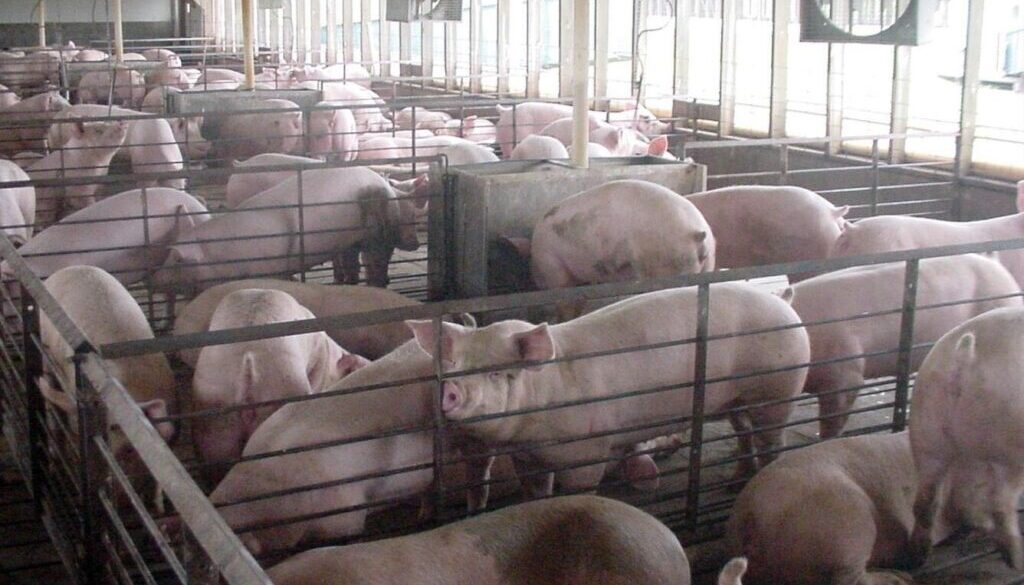Food and Water Watch is seeking to require EPA to reconsider its request for new regulations related to discharge from CAFOs. (Photo by Kent Becker, U.S. Geological Survey)
Federal appellate court judges heard oral arguments Thursday for a case filed by groups seeking stronger Environmental Protection Agency water pollution regulations at concentrated livestock operations.
The case, submitted by Food and Water Watch on behalf of environmental, community and state advocacy groups, including the Iowa Citizens for Community Improvement, asks that the court require the EPA to reconsider its denial of a 2017 petition brought forth by the group.
The original petition demanded EPA construct new regulations relating to polluting discharge from Concentrated Animal Feeding Operations, or CAFOs, per the Clean Water Act.
The petitioners describe CAFOs as “sewerless cities” and allege they are illegally polluting waterways because of “EPA’s ineffective regulatory scheme.”
A primary complaint against the current regulations is an agricultural stormwater exemption which the petitioners argue enables CAFOs to avoid regulation.
EPA denied the petition seven years later, in 2023, and formed a subcommittee to evaluate Clean Water Act regulations for CAFOs and the concerns brought forward in the petition.
Food and Water Watch submitted a petition for review of the denial in September 2023. That lawsuit was heard and submitted into the U.S. Court of Appeals for the Ninth Circuit in San Francisco Thursday. It argues the EPA’s decision to further study the issue will ensure “years more delay and (perpetuate) the ongoing harm that unchecked CAFO water pollution is inflicting on petitioners, their members, and communities across the country.”
Emily Miller gave oral arguments on behalf of Food and Water Watch in a lawsuit against the Environmental Protection Agency for their regulation of water pollution at CAFOs. (Screenshot from Youtube video by U.S. Court of Appeals for the 9th Circuit)
Emily Miller, representing Food and Water Watch, said the EPA’s actions allow it to further stall the process without committing the agency to reforming any of the regulations.
Senior Circuit Court Judge Jay Bybee said it did not make sense to ask the court to order the EPA to change its direction from studying the issue and making adjustments, to instead reconsidering the petition.
“This is a very awkward context,” Bybee said. “We’ve got to stand back and give the agency the room to do what it’s supposed to do.”
The lawsuit alleges there are nearly 10,000 unpermitted CAFOs discharging pollutants into waterways. Miller argued the EPA’s response would not address that concern.
“While (the studies) may play a role in improving (permitted) standards, they won’t address the heart of the problem, which is the widespread failure to permit in the first place,” Miller said.
Paul Cirino gave oral arguments on behalf of the EPA, as did a representative for the agency’s intervenor petitioners, the National Pork Producers Council, American Farm Bureau Federation, U.S. Poultry and Egg Association and United Egg Producers.
“It serves no purpose for the agency to simply do a rulemaking because they got a petition to do rulemaking, when it knows that there’s relevant information that’s out there … that’s going to be very relevant to their decision,” Cirino said.
Judges Jay Bybee, Carlos Bea and Salvador Mendoza, Jr. (left to right at top) of the U.S. Court of Appeals for the Ninth Circuit, heard oral arguments for Food and Water Watch v. Environmental Protection Agency. (U.S. Court of Appeals for the Ninth Circuit YouTube)
Judge Bybee asked Cirino, as a hypothetical, if the EPA was merely protecting itself politically through the creation of a subcommittee to gather this information.
“I don’t think that’s what’s happening here,” Cirino said. “I think EPA is more concerned about getting the information that’s out there in this nationwide industry, CAFOs, and making sure it adequately understands the problem and can select which of the tools it wants to use to address each of the issues that are in play.”
The judges present have an unlimited amount of time to make a decision on the case, though most cases are decided within three months to a year according to the court’s website.

